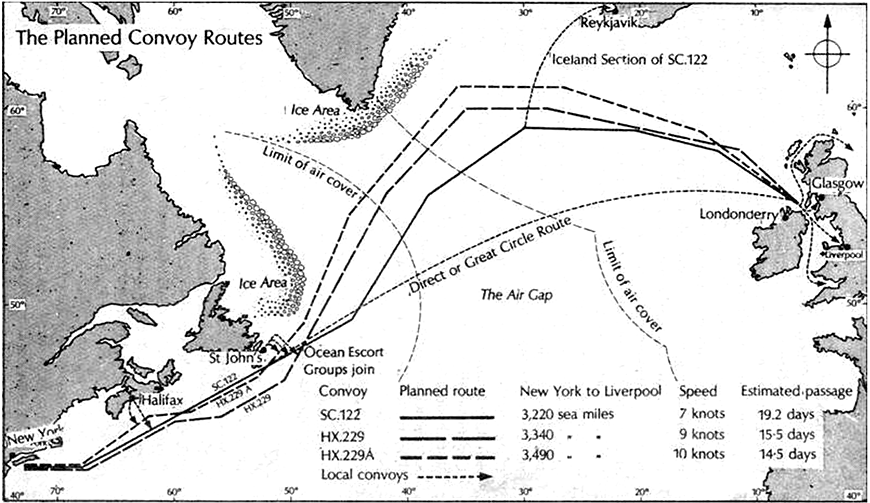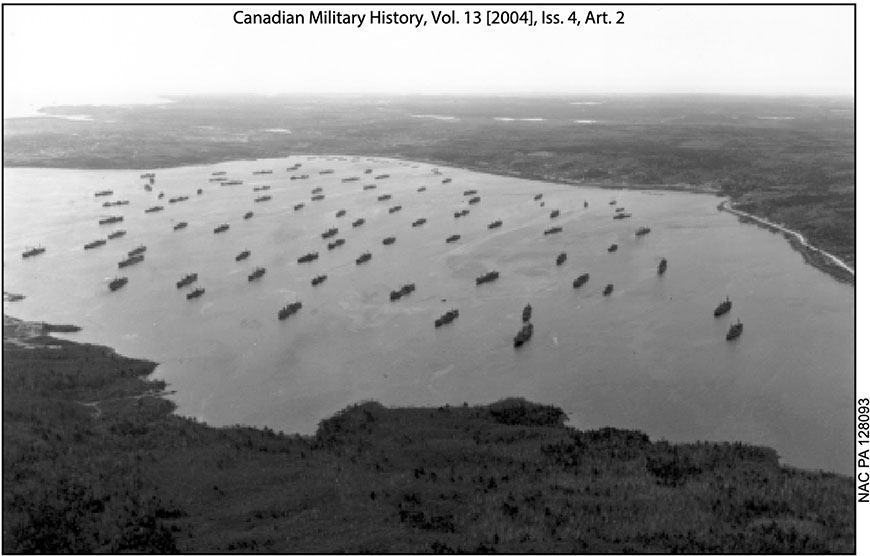Heading Off to the War - Nov & Dec 1944

Examples of some of the planned convoy routes during WWII
The Battle of the Atlantic
From 1939 until the defeat of Germany in 1945, German U-boats and warships and the Luftwaffe battled against the British and Canadian navies and air forces, and later those of the United States, to disrupt convoys coming mainly from North American and predominantly going to the United Kingdom and the Soviet Union.
When Second Lieutenant Hiram B. Ely, Jr, made that 14-day journey in convoy across the Atlantic in December 1944, the Allies had the upper hand in this battle, though losses due to U-boats did continue until the war's end.
Hi was in Convoy SC 162 consisting of 58 merchant and 25 escort ships.[1] The convoy was carrying lumber, pulp, steel, sugar, grain, explosives, navy stores, mail, and general supplies. Only two ships, Hi's and another, were carrying passengers.[2]
Fifty-three years later in Forty Four, the alumni newsletter of the West Point Class of 1944[3], Hi light-heartedly and with his usual sense of humor recounted his journey to the war in Europe:
I had just been married at West Point in October, honeymooned, and then was sent to Camp Kilmer, N.J. to await orders to Europe. There I met up with Gerry Hall, E.P. Anderson and L.C. Ellis along with the other thirteen who had completed the Ordnance Course at Aberdeen.

Hi Ely

Gerry Hall

E.P. Anderson

L.C. Ellis
The 17th of November eve we departed Kilmer for Philadelphia where we boarded the M.V. San Francisco, a Swedish freighter. Upon boarding, we discovered we were the only troops aboard. We had twin bedrooms, connected by a spacious lounge where we ate, read and played cards. Then to our surprise we were served a Swedish Smögasbord that would have been a complete meal; but it was only an appetite teaser. The meal continued.
We sailed for Boston at 4:00 p.m., arrived in Boston two days later, remained there two days then on to Halifax four days later where we dropped anchor to await convoy.
Getting stirbound we ordered ourselves ashore and did some shopping (I bought an old English antique grandfather clock to be shipped home). We still have this prized possession.

Safety in numbers—a convoy assembling in Bedford Basin, Halifax. Throughout WWII, Halifax was one of the ports used to assemble convoys headed for the UK. The above photo was taken in 1941.
Finally on the evening of December 2nd, we sailed from Halifax in convoy arriving in the north of Scotland at Loch Eves[4] on December 16th.
Although we could go on deck during the voyage, we were so low in the water it almost seemed we could sit and drape our legs over the gunnels into the ocean except it was too cold. Instead we stayed inside our beautiful lounge, played poker and ate (except for those who were seasick).
We continued on around Scotland finally debarking on the 19th of December in Methil, Scotland, several hours north of Edinburgh. To top the trip off, they took our gear ashore in rowboats. The ship was to continue on to London for unloading. They contended that their cargo of four second lieutenants fresh out of West Point was too valuable to the war effort to risk the trip through the English Channel. That was just the beginning of our adventure!
Footnotes & Sources
[1] Arnold Hague Convoy Database, accessed March 2023.
[2] Convoy SC 151 through SC 177, Warsailors.com by Siri Holm Lawson and Convoy SC 162, Warsailors.com by Siri Holm Lawson, accessed March 2023.
[3] Forty Four, the alumni newsletter of the West Point Class of 1944, Vol. 9, Fall 1997, p. 21.
[4] I believe he means Loch Ewe, not Loch Eves. Lock Ewe is a deepwater sea loch and was a wartime collection point. It has WWII buildings and a shipwreck memorial. Eves Loch is in the Orkney Islands and is not a port for large ships.
Published 16 July 2023.
